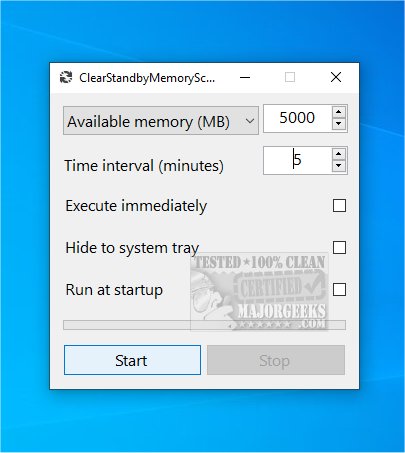The recent release of ClearStandbyMemoryScheduler 1.0.3.3 introduces an effective tool for optimizing system resource management by allowing users to schedule specific times for clearing standby memory. This feature is particularly beneficial for enhancing the performance of systems with limited RAM.
Understanding Standby Memory
Standby memory is a segment of RAM that temporarily stores data from recently accessed applications and files, facilitating faster access upon reopening them. However, this memory may not always be released when new programs demand resources, leading to potential slowdowns in system performance. ClearStandbyMemoryScheduler is designed to tackle this issue by automating the management of standby memory.
Key Features of ClearStandbyMemoryScheduler
ClearStandbyMemoryScheduler boasts a user-friendly interface, enabling users to set memory thresholds and the frequency of monitoring. When the monitored memory usage dips below the specified threshold, the application automatically clears the standby memory, thus freeing up RAM and improving system performance.
Users can launch and terminate the application manually or configure it to start automatically with the system. It can operate discreetly from the system tray, allowing for easy access through a context menu. The application is designed to run as a single instance, ensuring that only one copy is active at any time to prevent conflicts. It also runs with elevated permissions, ensuring it has the necessary access rights to perform its functions, with settings being saved persistently for user convenience.
Configuring Memory Thresholds
Users can set thresholds based on "Available Memory" or "Standby Memory." If available memory exceeds a specified amount in MB or if standby memory remains below a certain limit, the application will bypass the clearing operation. If no threshold is set, the system will clear memory after a specified duration. For systems with limited RAM, checking memory every minute can be particularly advantageous to maintain optimal performance.
Conclusion: A Valuable Tool for Users with Limited RAM
ClearStandbyMemoryScheduler is a valuable asset for users facing memory constraints. While Windows has built-in memory management capabilities, this tool enhances that functionality by actively freeing up memory, thus preventing slowdowns and potentially boosting overall system performance. Users with computers that could benefit from additional memory optimization should consider incorporating this tool into their system maintenance routine.
Additional Resources
For further insights on memory management, users may explore related topics such as using the Windows Memory Diagnostic Tool, checking RAM speed and slots, troubleshooting memory errors, and managing SysMain (formerly known as Superfetch). These resources can complement the benefits of ClearStandbyMemoryScheduler and provide a comprehensive approach to optimizing system performance
Understanding Standby Memory
Standby memory is a segment of RAM that temporarily stores data from recently accessed applications and files, facilitating faster access upon reopening them. However, this memory may not always be released when new programs demand resources, leading to potential slowdowns in system performance. ClearStandbyMemoryScheduler is designed to tackle this issue by automating the management of standby memory.
Key Features of ClearStandbyMemoryScheduler
ClearStandbyMemoryScheduler boasts a user-friendly interface, enabling users to set memory thresholds and the frequency of monitoring. When the monitored memory usage dips below the specified threshold, the application automatically clears the standby memory, thus freeing up RAM and improving system performance.
Users can launch and terminate the application manually or configure it to start automatically with the system. It can operate discreetly from the system tray, allowing for easy access through a context menu. The application is designed to run as a single instance, ensuring that only one copy is active at any time to prevent conflicts. It also runs with elevated permissions, ensuring it has the necessary access rights to perform its functions, with settings being saved persistently for user convenience.
Configuring Memory Thresholds
Users can set thresholds based on "Available Memory" or "Standby Memory." If available memory exceeds a specified amount in MB or if standby memory remains below a certain limit, the application will bypass the clearing operation. If no threshold is set, the system will clear memory after a specified duration. For systems with limited RAM, checking memory every minute can be particularly advantageous to maintain optimal performance.
Conclusion: A Valuable Tool for Users with Limited RAM
ClearStandbyMemoryScheduler is a valuable asset for users facing memory constraints. While Windows has built-in memory management capabilities, this tool enhances that functionality by actively freeing up memory, thus preventing slowdowns and potentially boosting overall system performance. Users with computers that could benefit from additional memory optimization should consider incorporating this tool into their system maintenance routine.
Additional Resources
For further insights on memory management, users may explore related topics such as using the Windows Memory Diagnostic Tool, checking RAM speed and slots, troubleshooting memory errors, and managing SysMain (formerly known as Superfetch). These resources can complement the benefits of ClearStandbyMemoryScheduler and provide a comprehensive approach to optimizing system performance
ClearStandbyMemoryScheduler 1.0.3.3 released
ClearStandbyMemoryScheduler enables you to set a specific time for clearing the standby memory, which can help you manage system resources efficiently.


